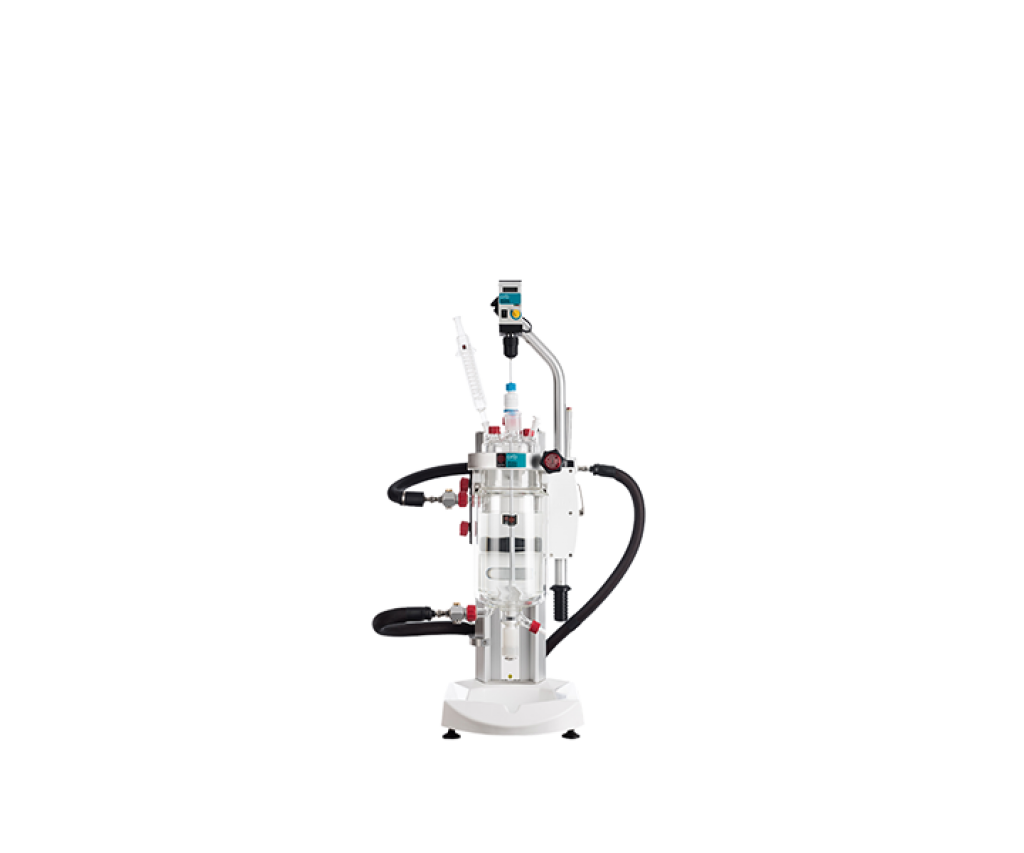Benchtop reactor systems: your comprehensive guide
Benchtop reactor systems are essential, versatile tools for chemists and engineers, bringing the capability of large-scale chemical processing right to your lab bench. They provide precise control over reaction parameters, enabling efficient research, process optimization, and small-scale synthesis. This guide will walk you through the types, key features, applications, and selection criteria for these chemical reactor systems, helping you choose the best system for your work.
What are benchtop reactor systems?
A benchtop reactor system is a compact assembly used for running chemical reactions under controlled conditions on a laboratory scale. They replace traditional round-bottom flasks with precision-engineered vessels and highly accurate control mechanisms. They are often modular and customizable, commonly featuring elements for stirring, heating, cooling, dosing, and monitoring.
What are the applications of benchtop reactors?
Benchtop reactors are vital across diverse sectors, including pharmaceutical, chemical, and materials science industries. They are crucial for process development, where precise control ensures that reactions can be reliably scaled up later. Researchers also use them for reaction kinetics studies, crystallization control, and testing new catalysis agents
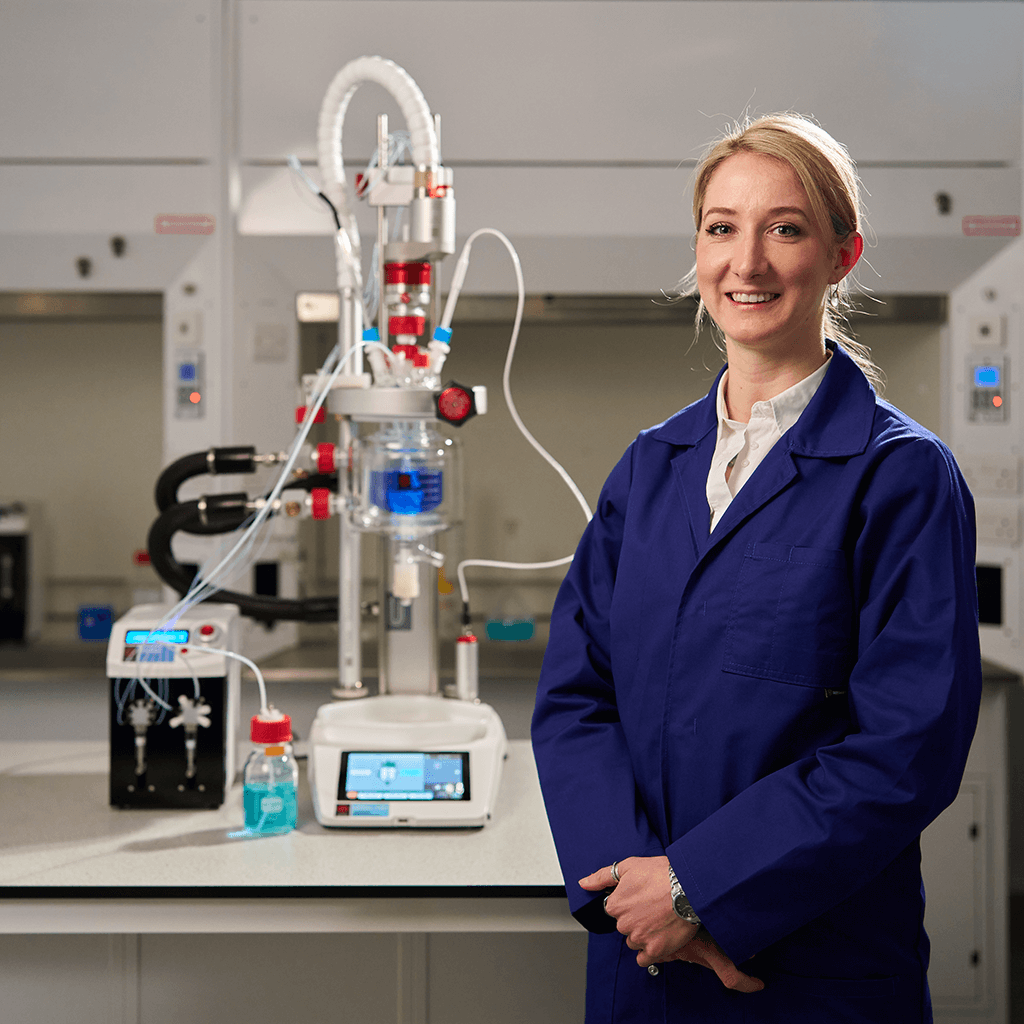
Why Use Benchtop Reactors? Benefits and Advantages
Using a dedicated benchtop reactor system offers several advantages over traditional glassware. These systems allow for superior temperature control via jackets and circulation units, minimizing temperature fluctuations which are critical for achieving high reliability and reproducibility of results. Their construction, often featuring safety interlocks and automated controlled dosing, significantly improves safety when handling exothermic or hazardous reactions. This reliable automation frees up scientists, allowing for valuable walk-away time.
Types of benchtop reactor systems
Benchtop reactors come in many forms, each suited to different chemical needs. A benchtop jacketed reactor is perhaps the most common type.
- Jacketed reactors: These use a double-walled jacketed vessel where thermal fluid (from a circulator) flows to precisely control the internal reaction temperature over a wide range. They offer exceptional control and are modular for easy assembly.
- High pressure reactors: Designed as a high-pressure vessel to safely contain reactions at elevated pressures, these are essential for processes like hydrogenation or carbonylation, where the Maximum Allowable Working Pressure (MAWP) must be strictly managed for safety.
- Glass reactors: Using glass reactor vessels, these systems offer high chemical inertness, excellent thermal properties, and superior visibility, allowing chemists to directly observe changes during a reaction.
- Automated systems: These automated benchtop reactor systems use automation software and intelligent control units to run complex, multi-step stirring, dosing, and heating profiles without manual intervention.
- Mini reactors: Used for micro-scale testing, these small lab reactors minimize reagent use, accelerating screening experiments and saving costs.
Continuous vs. batch reactors
Benchtop systems can support both batch and continuous reaction principles:
- Continuous Stirred-Tank Reactors (CSTR): Used primarily for liquid-phase batch reactions, a CSTR, sometimes known as a stirred reactor, is modeled as a vessel where input and output streams are continuous, but the contents are perfectly mixed. They are ideal for systems where precise mixing and bulk production are key. Syrris offer the Atlas HD Automated Jacketed Reactor and Orb Jacketed Reactor which provides all these functionalities and more.
- Plug Flow Reactors (PFR): These continuous process reactors are often tubes or coils where fluid moves as a ‘plug,’ and reaction time is based on flow rate. They are preferred for flow chemistry or synthesis where precise control over residence time and temperature gradients is critical, typically yielding smaller reaction volumes than CSTRs. See the Asia Flow Chemistry System for more information.
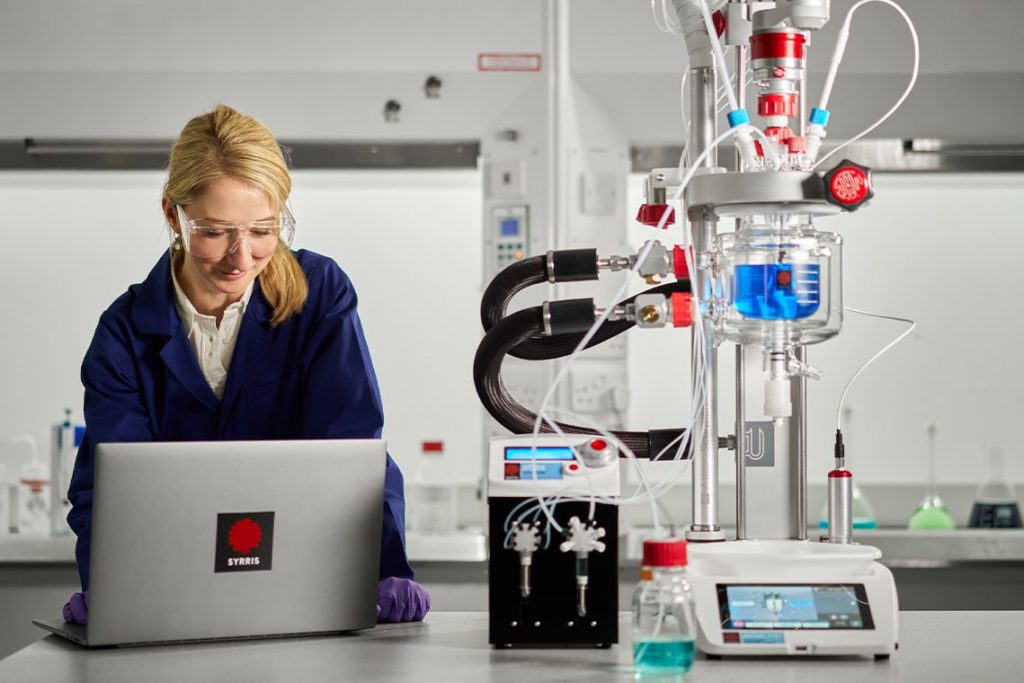
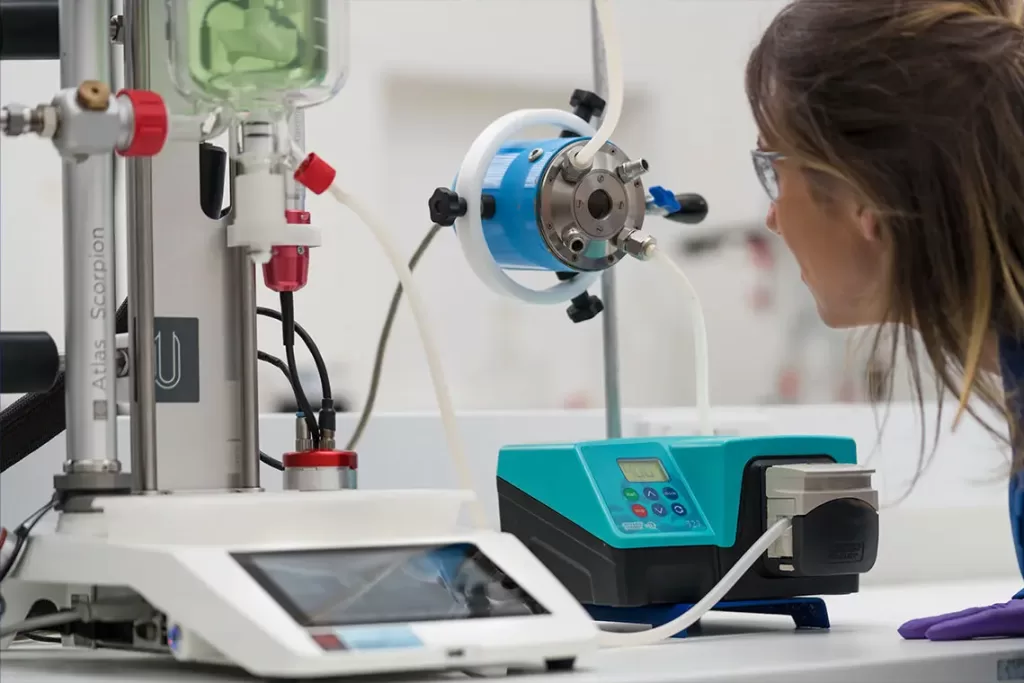
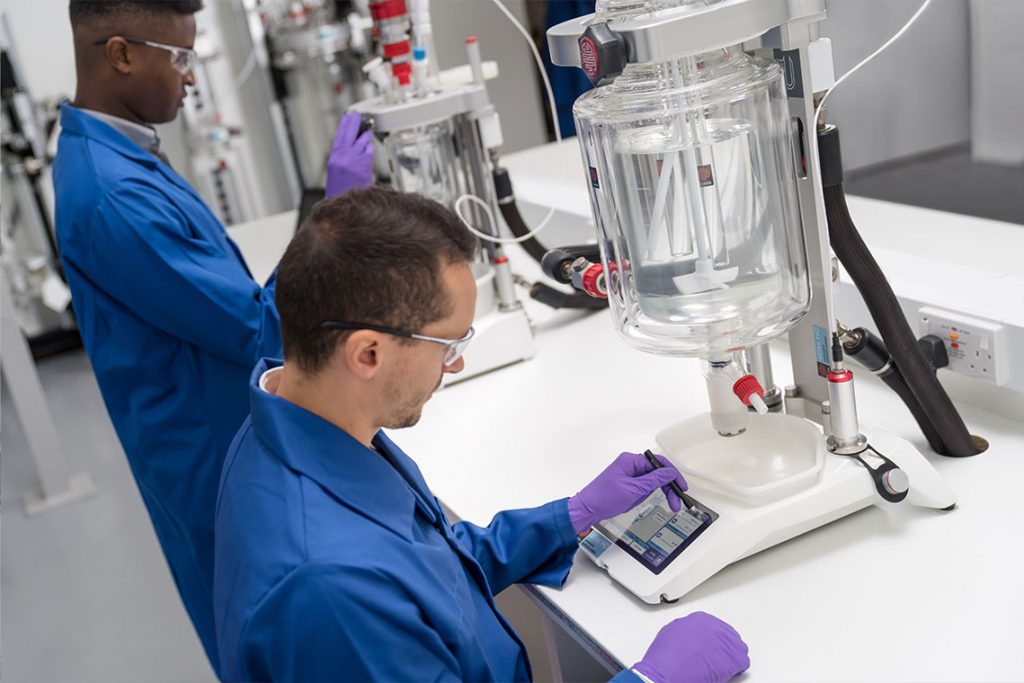
Key features and considerations
Temperature Control
Temperature regulation is performed through a closed-loop system called proportional–integral–derivative controller (PID control). This feedback mechanism (the temperature control loop) constantly adjusts the energy output of the circulator based on readings from the sensors/probes inside the vessel, ensuring the reactor temperature remains stable and accurate. Benchtop units can support wide temperature ranges, with many models, including the Atlas HD Automated Jacketed Reactor capable of cryogenic temperatures down to -90°C and high temperatures up to +250°C.
Stirring/agitation
The heart of the system, the overhead stirrer, controls mixing and efficiency. It’s crucial to select the correct type and size of stirrer for your reactor volume and fluid viscosity. Speeds in a stirred reactor can be precisely controlled, often up to 800 rpm.
Pressure rating
When working with high pressure, the benchtop jacketed reactor vessel must adhere to its MAWP. High pressure systems require robust materials and safety measures like a pressure relief valve (PRV) or rupture disc to prevent catastrophic failure.
Vessel size, volume, and materials
Standard benchtop lab reactor vessel sizes, often available in both glass (borosilicate) and stainless steel, range from 100 mL up to 10 L. You must consider the working volume (actual reaction volume) versus the total volume (maximum capacity) to allow for expansion and mixing. Seals, such as FFKM O-rings (perfluoroelastomer) or FKM O-rings (fluoroelastomer), are essential for chemical and thermal resistance.
Automation
Automation enables advanced operation, including complex recipe programming, data acquisition, and remote monitoring. Capabilities range from basic pump, stirring, and temperature control (like PID control loops) to advanced functions like sampling, Process Analytical Technology (PAT) integration, audit trails, and data export in usable formats (including CSV files). Choosing a platform that seamlessly integrates all components in your chemistry workflow is key.
Safety features
Safety features are non-negotiable. These include mechanical features like the PRV and rupture disc (for overpressure protection) and electronic safety interlocks that automatically shut down heating or stirring if limits are exceeded.
Applications of benchtop reactor systems
Benchtop reactor systems provide the precision necessary for success in diverse chemical fields.
- Process development & scaling up: Used to rigorously define and optimize reaction conditions—such as reactant ratios, solvent effects, and temperature ramps—before scaling the process to pilot or production plants.
- Process safety & hazards: Critical for performing thermal hazard and stability studies. High-accuracy control systems allow scientists to evaluate thermal runaway risks and design safer working conditions.
- Synthesis & new compounds: Facilitates the creation of new chemical entities, including intermediates and APIs.
- Crystallization: Precise temperature and stirring control are used to regulate nucleation and crystal growth, enabling the control of a product’s size and morphology. Addition of a turbidity probe can help in mapping the Metastable Zone Width (MSZW) where supersaturation occurs.
- Formulation: Developing new formulations and optimizing existing ones.
- Polymerization: Synthesizing polymers and copolymers and determining molecular weight distributions.
- Catalysis: Provides reproducible conditions to screen catalysts and analyze reaction kinetics efficiently.
Automated syringe pumps: cost analysis and comparison
HPLC type pumps can be used in flow chemistry applications. HPLC pumps are typically dual-piston pumps, although single reciprocating piston pumps can be used. The two pistons are out of phase, like continuous syringe pumps; while one pump head fills, the other delivers.
The material of construction can be 316 stainless steel, titanium, Hastelloy C or ceramic. Stainless steel pumps are most common and can have chemical compatibility issues, so you need to be careful with the construction material.
Regulatory compliance and safety standards
Ensuring regulatory compliance is a major pain point for benchtop reactor buyers, yet essential for laboratory safety and later product commercialization.
- Relevant safety standards: All electrical equipment used in the lab must comply with standards such as IEC 61010-1/61010-2-010.
- Pressure vessel codes: Any system that operates under pressure must meet strict codes. In the EU, this means compliance with the Pressure Equipment Directive (PED) 2014/68/EU, while in the UK, the Pressure Equipment (Safety) Regulations 2016 (UKCA) These require proper documentation and certification. Pressure systems guidance is provided by bodies like the HSE (UK).
- Documentation and training: You should expect detailed documentation on material conformity, pressure ratings, and operating instructions. Proper training on the safe operation and maintenance of the equipment, especially high-pressure systems, is crucial for minimizing risks.

Choosing the right benchtop reactor system
Selecting a benchtop lab reactor doesn’t have to be difficult if you follow a structured approach.
- Define the requirements of the application: Determine your core needs: the reaction temperature/pressure range, minimum and maximum vessel sizes needed (e.g., 100 mL to 10 L, and the necessary level of stirring and mixing efficiency.
- Evaluate types and features: Decide if you need a modular jacketed reactor or a specialized high-pressure reactor. Assess the automation options and required data logging capabilities.
- Consider lifecycle costs: Factor in the initial purchase price, but also long-term costs like maintenance spares (O-rings, glassware), energy use (heating/cooling), and potential downtime risks.
- Consider materials: Assess what chemicals you are processing, what construction of vessel, such as a jacketed glass reactor vessel (constructed from borosilicate glass) or stainless steel, do you require?
- Consult experts: Always contact the sales team for a consultation or to request a quote. Leverage their expertise for customization options, technical support, and ensuring compliance. You can contact the Syrris team here.
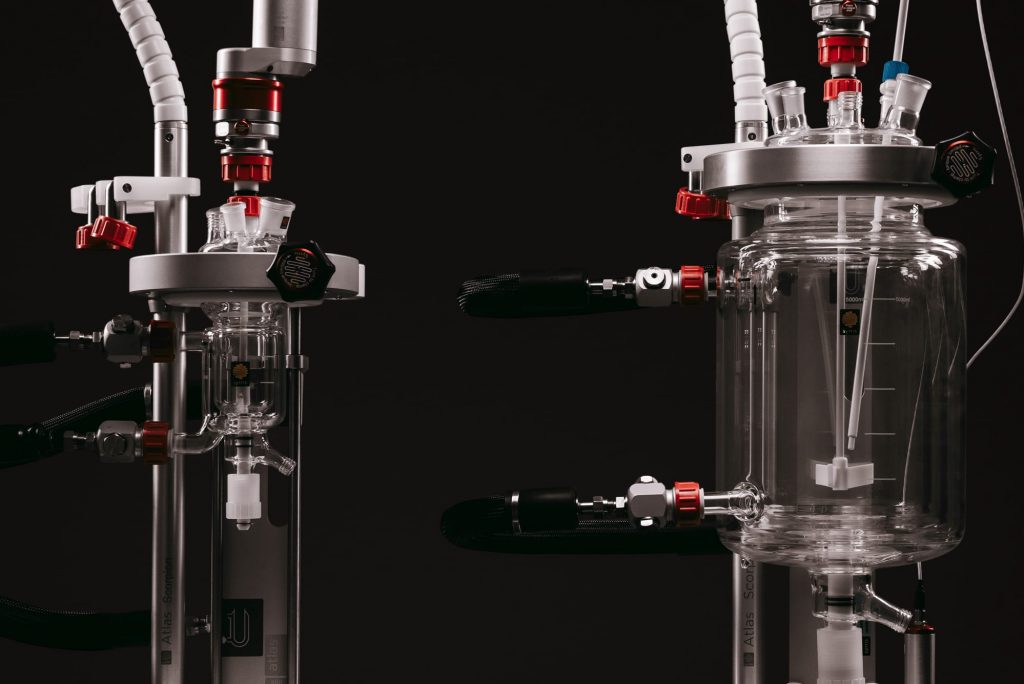
Contact us
Contact our specialists for help choosing the best benchtop reactor system for your application.
Ask us:
- What is the correct reactor vessel material for your chemistry
- What vessel size do you need
- How to customize your benchtop reactor
- What reactor automation software is best
Benchtop reactor systems terminology
When selecting your Benchtop Reactor System, you should be aware of the following terms used by manufacturers when describing their products:
- MAWP: Maximum Allowable Working Pressure
- psi: Pounds per square inch (pressure unit)
- bar: Unit of pressure
- Working volume vs total volume
- FKM O-ring: Type of O-ring material (fluoroelastomer)
- FFKM O-ring: Type of O-ring material (perfluoroelastomer)
- PRV (pressure relief valve)
- PTFE: Polytetrafluoroethylene
- PID (Proportional–integral–derivative) control: Type of feedback control system
- PAT: Process Analytical Technology
Syrris products featured in this article

Atlas HD Jacketed Reactor
